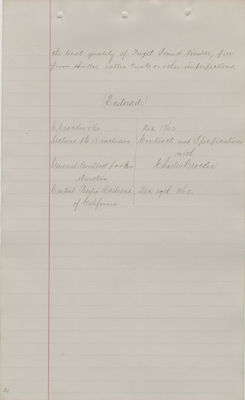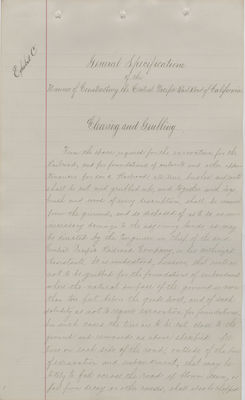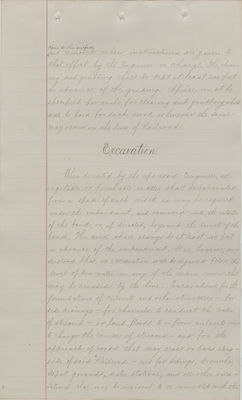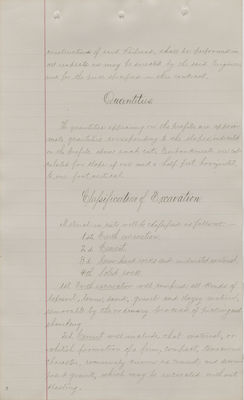Pages
Robinson_09051867__0391
the best quality of Puget Sound timber, free from shakes, rotten knots or other imperfections.
Endorsed:[centered]
C. Crocker & Co. Sections 1 to 18 inclusive
General Contract for Con struction
Central Pacific Railroad of California
Dec. 1862 Contract and Specifications with Charles Crocker
Dec. 29th. 1862.
[bottom left margin:] 30
Robinson_09051867__0392
Exhibit "C." [left margin]
General Specifications[centered] of the[centered] Manner of Constructing the Central Pacific Rail Road of California.
Clearing and Grubbing[centered]
From the space required for the excavation for the Railroad, and for foundations of culverts and other appur= tenances for said Railroad, all trees, bushes and roots shall be cut and grubbed up, and together with logs, brush and wood of every description, shall be removed from the ground, and so disposed of as to do no un= necessary damage to the ajoining lands, as may be directed by the Engineer in Chief of the said Central Pacific Railroad Company, or his authorized Assistants. It is understood, however, that roots are not to be grubbed for the foundations of embankments where the natural surface of the ground is more than two feet below the grade level, and of such solidity as not to require excavation for foundations. In such cases the trees are to be cut close to the ground and removed as above specified. All trees on each side of the road, outside of the line of excavation and embankment, that may be likely to fall across the road if blown down, or fall from decay or other causes, shall also be chopped
[bottom left margin:] 1
Robinson_09051867__0393
[caret, inserted above first line]"close to the surface" and removed when instructions are given to that effect by the Engineer in charge. The clear= ing and grubbing shall be kept at least 200 feet in advance of the grading. A price must be specified per mile for clearing and grubbing, which will be paid for such work whenever the same may occur on the line of Railroad.
Excavation.[centered]
When directed by the aforesaid Engineer, all vegetable or perishable matter shall be excavated from a space of such width as may be required under the embankment, and removed into the outside of the bank, or, if directed, beyond the limits of the bank. This work shall always be at least 100 feet in advance of the embankment. It is, however, un= derstood that no excavation will be required below the level of low water in any of the main rivers that may be crossed by the line. Excavations for the foundations of culverts and other structures — for side drainage — for channels to conduct the water of streams — or land floods to or from culverts — or to change the course of streams — and for the approach of roads that may cross or pass along= side of said Railroad — and for sidings, branches, depot grounds, water stations, and all other exca= vations that may be incident to or connected with the
[bottom left margin:] 2
Robinson_09051867__0394
construction of said Railroad, shall be performed in all respects as may be directed by the said Engineer, and for the price specified in this contract.
Quantities.[centered]
The quantities appearing on the profile are appoxi= mate quantities corresponding to the slopes indicated on the profile above each cut. Embankments are cal= culated for slope of one and a half feet horizontal, to one foot vertical.
Classification of Excavation.[centered]
Material in cuts will be classified as follows: —
1st. Earth excavation.
2d. Cement.
3d. Semi-hard rocks and indurated material.
4th. Solid rock.
1st. "Earth excavation"[underlined] will comprise all kinds of top-soil, loam, sand, gravel and clayey material, removable by the ordinary process of picking and shoveling.
2d. "Cement"[underlined] will include that material, on whitish formation of a firm, compact, tenacious character, commonly known as cement; and decom= posed granite, which may be excavated with out blasting.
[bottom left margin:] 3
Robinson_09051867__0395
3d. "Semi-hard Rock"[underlined] and "Indurated Material"[underlined], is intended to include all friable, argillaceous or cal= careous rocks, loose rock, boulders containing over five cubic feet; also, hard pan, decayed granite and indurated or cemented earth and gravel, which can not be excavated without blasting.
4th. "Solid Rock"[underlined] is intended to include granite ledge, trap rock, quartz rock, iron stone, blue hard rock, jasper rock, and all other rocks of this character.
Width and Slopes of Excavations.[centered]
The slopes and widths will be varied according to the material. The slopes is "Solid Rock"[underlined] and "Granite"[underlined] will be generally half a foot horizontal, to one foot vertical. The width of cuts at grade gener= ally eighteen feet, and cuts in this material will be excavated generally one foot below "level"[crossed out] grade.
Slopes in "Semi-Hard Rock, Decayed Granite"[underlined] etc., will be generally half a foot horizontal, to one foot vertical. The width at grade [caret]"will be" generally [caret]"eighteen" "nineteen"[crossed out] feet, and cuts will be excavated generally nine inches below grade.
Slopes in "Cement"[underlined] will be generally nine inches horizontal, to one foot vertical. The width at grade generally nineteen feet, and cuts will be excavated generally nine inches below grade.
[bottom left margin:] 4




